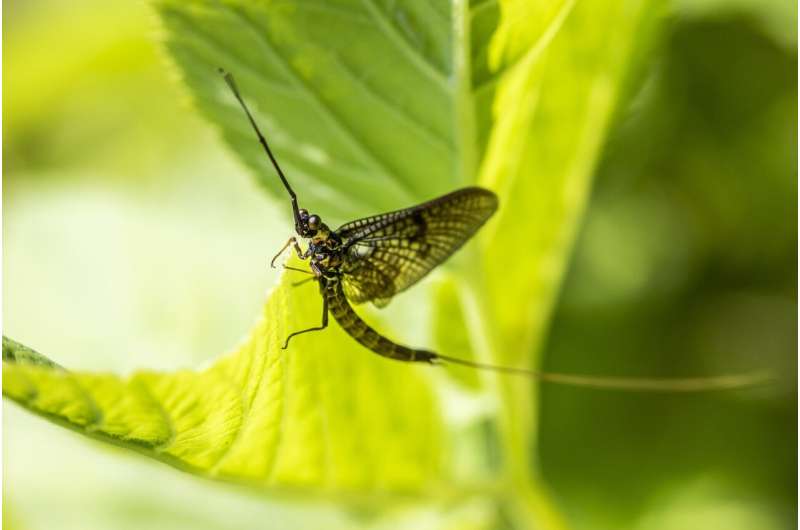This article has been reviewed according to Science X's editorial process and policies. Editors have highlighted the following attributes while ensuring the content's credibility:
fact-checked
peer-reviewed publication
trusted source
proofread
Consistent metabolism may prove costly for insects in saltier water

Increased salinity usually spells trouble for freshwater insects like mayflies. A new study from North Carolina State University finds that the lack of metabolic responses to salinity may explain why some freshwater insects often struggle in higher salinity, while other freshwater invertebrates (like mollusks and crustaceans) thrive. Salinity in this case refers to the concentrations of all the salts in an aquatic environment, not just sodium.
The work appears in the Journal of Experimental Biology.
"Freshwater habitats in general are getting saltier for a number of reasons, including road salt and agricultural runoff, extraction of coal and natural gas, drought, and sea level rise," says David Buchwalter, professor of toxicology at NC State and corresponding author of the research. "Freshwater insects and other organisms that live in these systems are used as indicators of the ecosystem's health. When these systems get saltier, we see that insect diversity decreases, but we aren't sure why."
Aquatic animals (including insects and crustaceans) must constantly maintain the correct balance of water and salts within their body—a process called osmoregulation. Theoretically, the most favorable environment for aquatic animals would be one where external salinity levels are close to those inside the animal. That way the animal doesn't have to work as hard to maintain osmoregulation.
However, the opposite seems to be true for freshwater insects—higher salinity is always associated with increased rates of ion uptake in insects, but it is also associated with developmental delays or death.
"We thought that freshwater insects might be shifting so much of their energy toward osmoregulation in saltier environments that they cannot grow or thrive," Buchwalter says. "So we measured the metabolic rates of crustaceans and insects in dilute and saline environments to see if metabolic responses to salinity were similar."
The team looked at three types of freshwater animals—two species of gammarid, or "scud," which is a small freshwater crustacean; one freshwater snail; and three aquatic insect species.
In the first test, they measured the animals' metabolism by placing them in waters with different concentrations of salt ions and looking at their rates of oxygen consumption. They observed that more dilute conditions made the crustaceans and snail breathe harder, increasing their metabolism, while insects' metabolic rates were constant regardless of salinity.
Next, the team looked at whether an increase in breathing rates was linked to the transport of a particular ion. Radioactive isotopes of the salt ions calcium and sodium allowed the researchers to measure how much and how quickly the animals took up different ions.
The researchers found that calcium was the key driver of non-insects' increased metabolism in lower salinity. In other words, the crustaceans and snail worked harder to transport the calcium ions they required in an environment where calcium was harder to find.
In contrast, the insects' metabolic rates remained constant in both saline and dilute environments, even though they had a higher calcium ion transport rate in the saline environment. Insects seem to have very little demand for calcium; in fact, previous research has shown that excess calcium is potentially toxic to them.
The researchers think that the animals' use of internal energy, or active transport, when moving the salts could be the explanation.
"When we see non-insects' metabolisms increase in dilute environments, it could be due to the fact that they have to work harder to take in more calcium," Buchwalter says. "And while it seems counterintuitive, the opposite is true for insects who are working harder in a more saline environment to maintain equilibrium, although their respiration rates don't increase. Instead, they appear to utilize resources that would otherwise be dedicated to growth and development to 'undo' excessive ion uptake when things get saltier."
"Moving salt ions has an energy cost to the animal," Buchwalter says. "So for freshwater insects, the idea that organisms should thrive in environments that are close to their internal salinity is wrong. Additionally, their low demand for calcium may help them thrive in very dilute environments where insects typically dominate the ecology. In contrast, low calcium appears to be stressful for the crustaceans and snail in this study. It is fascinating that species living in the same habitats can have such different physiologies."
Future work will explore whether these physiological differences are based on the ancestry of the organisms tested, or the use of calcium in their exoskeletons/shells.
More information: Jamie K. Cochran et al, Respirometry reveals major lineage-based differences in the energetics of osmoregulation in aquatic invertebrate, Journal of Experimental Biology (2023). DOI: 10.1242/jeb.246376
Journal information: Journal of Experimental Biology
Provided by North Carolina State University



















